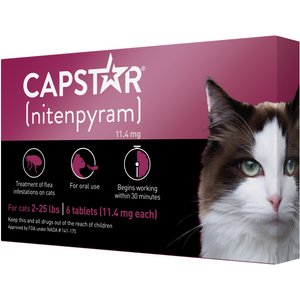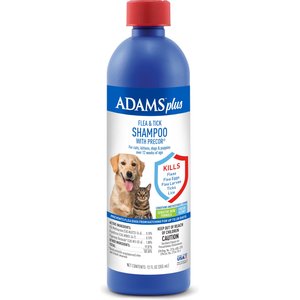Fleas are the worst. They cause a lot of discomfort for your cats and dogs, and even more concerning, flea bites can result in problems like cat scratch fever and flea allergy dermatitis. And, not to make this all about us, but no human wants to be bitten by fleas.
Should your furry friend end up with a flea infestation, oral flea medications such as Capstar, which is safe for dogs and cats, can be a highly effective way to quickly kill the adult fleas that are making your furry friend miserable. We spoke to vet experts to learn all about this over-the-counter oral tablet.
Is Capstar Safe for Dogs and Cats?
Click to jump to each section.
What Is Capstar? And How Does Capstar Work?
The flea treatment works quickly, is highly effective and is safe for daily use during a flea infestation. It’s so fast-acting that fleas will begin dying within 30 minutes of the first dose.
So, how does Capstar kill fleas? The active ingredient, nitenpyram, is an insecticide that wipes out adult fleas. The nitenpyram enters your pet’s bloodstream and when a flea bites your furry BFF, the flea ingests the nitenpyram.
The insecticide then attacks the flea’s nervous system, causing paralysis and then death. It may sound a little gruesome at first—until we remember that we’re talking about fleas here! Then it sounds pretty good.
How Much Does Capstar Cost?
The price of Capstar varies slightly between the type of pet you’re treating (cat or dog) as well as their weight if your pet is a dog.
How Long Does Capstar Last?
Capstar is extremely fast-acting. One Capstar tablet will have the tiny parasites dropping dead within 30 minutes. However, Capstar is also short-lived. This super-simple flea treatment will continue working for 24 hours after administration, with all benefits ending by 48 hours.
Capstar Side Effects and Adverse Reactions
“If side effects occur, they usually occur in pets less than 8 weeks of age,” explains Dr. Dwight Alleyne, DVM, a practicing veterinarian in Georgia. Other circumstances that increase the risk of side effects and death include giving Capstar to pets who weigh less than 2 pounds and to pets whose weight is outside a healthy range.
However, it’s always wise to be aware of potential issues your pet may experience while taking any medication, no matter how small the chance.
The U.S. Food and Drug Administration (FDA) lists the following side effects and adverse reactions that a dog or cat could potentially experience from Capstar. Note that they are listed in order of frequency, with the potential issues at the top of the list being more frequently reported and those at the bottom being less frequently reported.
Dogs:
- Lethargy and depression
- Vomiting
- Itching
- Decreased appetite
- Diarrhea
- Hyperactivity
- Lack of coordination
- Trembling
- Seizures
- Panting
- Allergic reactions including hives
- Vocalization
- Salivation
- Fever
- Nervousness
Cats:
- Hyperactivity
- Panting
- Lethargy
- Itching
- Vocalization
- Vomiting
- Fever
- Decreased appetite
- Nervousness
- Diarrhea
- Difficulty breathing
- Salivation
- Lack of coordination
- Seizures
- Pupil dilation
- Increased heart rate
- Trembling
Capstar Recommended Dose
Cat or Dog
2-25 pounds
One tablet
11.4 mg
Dog
25.1-125 pounds
One tablet
57 mg
While a single dose of Capstar usually takes care of a flea problem, it's possible for an initial infestation to be severe enough that some fleas will remain after 24 hours. It’s also possible for your pet to experience a reinfestation after the initial infestation has cleared up.
If either of these situations occur, it's generally safe to give your dog or cat another Capstar tablet one to two days after the first one. You can continue daily or weekly administration for as long as fleas are present.
Keep in mind, however, that some pets may have side effects, like temporary nausea or loose stools, with daily use.
How To Administer Capstar for Dogs and Cats
- Place the pill directly in their mouth.
- Hide the pill in food, making sure your pet actually ingests the Capstar tablet. (Some dogs and cats are masters at eating the food and spitting out the pill.)
- Crush the Capstar pill and mix it with a favorite food, like peanut butter. (Be certain the peanut butter doesn’t contain xylitol, as it’s toxic to dogs and cats.) Choose a food you know your pet will love, as there’s no recovering crushed pill powder if your dog or cat turns their nose to your offering.
Have a pet who isn’t fond of pills? Want to avoid that not-so-fun WWE-style wrestling match with your furry friend? Try one or more of our useful pill-giving tricks found in these guides:
Four Ways to Give a Dog a Pill (So They’ll Actually Swallow It)
A Vet-Approved Guide to Giving a Cat a Pill (Yes, It Is Possible)
How To Store Capstar
Although this recommendation isn’t made specifically for Capstar, it’s generally best to keep medications away from humid places, like laundry rooms and bathrooms, and instead store them in dry locations.
Be sure to keep Capstar (and all other medications) out of reach of children as well as your dogs and cats.
Important Capstar Considerations
- Capstar is not safe for dogs or cats who weigh less than 2 pounds.
- No matter your pet’s weight, Capstar is not safe for dogs and cats who are under 4 weeks of age.
- There are three Capstar products available, according to pet size:
- Dogs between 2 and 25 pounds
- Dogs between 25.1 and 125 pounds
- Cats between 2 and 25 pounds
- Ensure you’re using the correct Capstar product for your type of pet (cat or dog) as well as the correct strength if you’re giving Capstar to a dog. It would be very unsafe to mistakenly give a small dog under 25 pounds the strength meant for a large dog. Reversed—giving a large dog the strength meant for a small dog—would make it less effective.
- Capstar is generally safe for pregnant and nursing dogs and cats, though in some instances health issues may arise after use.
- If your pet has liver or kidney disease, Capstar is very likely safe for them. However, Capstar is metabolized in your pet's liver and eliminated in their kidneys, so there's a rare chance that Capstar could increase their risk of certain complications, according to Dr. Ochoa. Please ask your vet for advice."
- The FDA says Capstar is safe to use with most other medications and products, such as heartworm preventatives, deworming medications, antibiotics, corticosteroids, vaccines and other flea products.
- The FDA also notes that after Capstar administration, your pet may scratch themselves as the fleas begin to die. Don’t stress, as the scratching is a reaction to the fleas rather than the Capstar. You may also notice your dog or cat showing transient signs of hyperactivity, panting, vocalization and excessive grooming or licking.
Don’t Forget Flea Prevention
The most effective flea prevention on the market are topical or oral treatments, like chewables.
Both have powerful ingredients designed to kill off adult fleas, and some kill the flea eggs and larvae, too. The result: Your pets and your home will remain flea-free.
In short, the best way to deal with fleas is to avoid them in the first place by using a flea preventative.
However, if you’ve been lax about prevention by skipping those preventative treatment meds and now you’ve spotted fleas on your fur babies, Capstar could save the day.
After you’ve used this fast-acting solution to clear up the flea infestation, don’t forget to take steps to prevent a re-infestation.
The following information will help ensure a flea-free future for your pets:
FAQs About Capstar for Dogs and Cats
Q:
Do vets recommend Capstar for dogs?
Q:
Does Capstar work?
Q:
How long does Capstar work on cats?
Q:
Does Capstar kill flea eggs?
Q:
Does Capstar kill ticks?
Q:
Is Capstar safer than Frontline?
Q:
Is Capstar safe for pregnant dogs?
More about fleas and flea treatment:
Share:
















